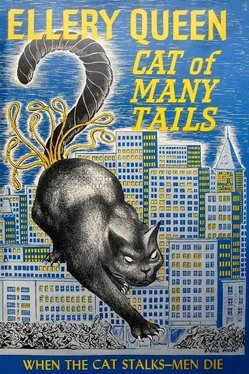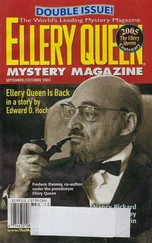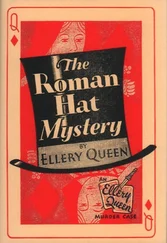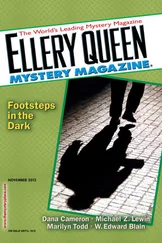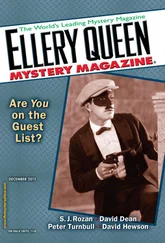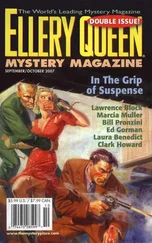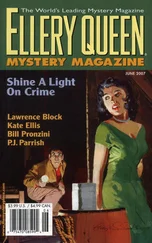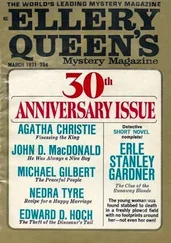“Just put me in a cab, Jimmy.”
“Are you going to be pork-headed?”
“I’ll be as safe on 102nd Street as on Park Avenue.”
“How about compromising in a — I mean on a hotel?”
“Jimmy, you’re wasting Mr. Queen’s time.”
“Wait for me, Ellery. I’ll go downtown with you.”
They went out, Jimmy still arguing.
Ellery shut the door after them carefully. Then he went back to the radio, turned it on, and sat down on the edge of the chair, like an audience.
But at the first blat of the newscaster he leaped, throttled the voice, and hurried to his bedroom.
It was afterward said that the press conference and radio talk of the Mayor’s Special Investigator on that topsyturvy night of Friday, September 23, acted as a brake on the flight of New Yorkers from the City and in a matter of hours brought the panic phase of the case to a complete stop. Certainly the crisis was successfully passed that night and never again reached a peak. But what few realized who were following the complex psychology of the period was that something comparably undesirable replaced it.
As people straggled back to the City in the next day or so, it was remarked that they no longer seemed interested in the Cat case. The cataract of telephone calls and in-person inquiries which had kept City Hall, Police Headquarters, and precincts all over the City swamped for almost four months ebbed to a trickle. Elected officials, who had been under continuous bombardment from their constituents, discovered that the siege had unaccountably lifted. For once, to their relief, ward politicians found their clubhouses deserted. Vox populi, which had kept the correspondence columns of the newspapers in an uproar, sank to a petty whisper.
An even more significant phenomenon was observed.
On Sunday, September 25, churches of all denominations throughout the City suffered a marked drop in attendance. While this fall from grace was deplored by the clergy, it was almost unanimously regarded by lay observers as an agreeable evil, considering “the recent past.” (Already the panic had dwindled to the size of a footnote in the City’s history, so dramatic was the change.) The unusually heavy church attendance during the summer, these observers said, had been inspired largely by Cat-generated fears and a panic flight to spiritual reassurance; the sudden wholesale defection could only mean that the panic was over, the pendulum had swung to the other extreme. Shortly, they predicted, church attendance would find itself back in the normal rhythm.
On all sides responsible people were congratulating one another and the City on “the return to sanity.” It was recognized that the threat to the City’s young people had to be guarded against, and special measures were planned, but everyone seemed to feel — in official quarters that the worst was over.
It was almost as if the Cat had been caught.
But there were contrary signs to be seen by those who were not blinded by sheer relief.
During the week beginning Saturday, September 24, Variety and Broadway columnists began to report an extraordinary increase in night club and theater attendance. The upswing could not be ascribed to seasonal change; it was too abrupt. Theaters which had not seen a full house all summer found themselves under the pleasant compulsion to rehire laidoff ushers and hall out ropes and S.R.O. signs. Clubs which had been staggering along were regarding their jammed dance floors with amazement; the famous ones were haughtily turning people away again. Broadway bars and eating places sprang to jubilant life. Florist shops, candy shops, cigar stores were crowded. Liquor stores tripled their sales. Scalpers, barkers, and steerers began to smile again. Bookmakers rubbed their eyes at the flow of bets. Sports arenas and stadiums reported record receipts and new attendance marks. Pool room and bowling alleys put on extra employees. The shooting galleries on Broadway, 42nd Street, Sixth Avenue were mobbed.
Overnight, it seemed, show business and its feedline subsidiaries began to enjoy boomtime prosperity. Times Square from sundown to 3 A.M. was roaring and impassable. Taxi drivers were saying, “It’s just like the war all over again.”
The phenomenon was not restricted to midtown Manhattan. It was simultaneously experienced by the entertainment districts of downtown Brooklyn, Fordham Road in the Bronx, and other localities throughout the five boroughs.
That week, too, advertising agency executives were bewildered by advance reports from their radio-polling services. At a time when most major radio shows had returned to the air to begin the fall and winter broadcasting cycles and an appreciable rise in listener-response should have become apparent, the advance ratings unaccountably dropped in the metropolitan area. All networks were affected. The independent stations with local coverage had Pulse and BMB make hasty special surveys and discovered that the bottom had fallen out of their program-response and listener-circulation tables. The most significant of all — in all surveys — were those showing the percentage of sets-in-use. They were unprecedentedly small.
A parallel drop was noted in television surveys.
New Yorkers were not listening to. the radio and watching the telecasts.
Account executives and broadcasting company vice-presidents were busy preparing explanations to their clients, chiefly masochistic. The truth seemed to have occurred to none of them, which was that radio and television sets could not be turned on in the home by people who were not there or why, if they were, were absent spiritually.
Police were puzzled by the abrupt rise in drunkenness and disorderly conduct cases. Routine raids on gambling houses bagged huge takes and a type of burgher clientele not ordinarily found throwing its money away. Marijuana and narcotics cases took a disturbing jump. The Vice Squad was compelled to put on a co-ordinated drive in an attempt to curb the sudden spread and acceleration of prostitution activities. Muggings, car thefts, holdups, common assaults, sex offenses increased sharply. The rise in juvenile delinquency was especially alarming.
And of peculiar interest was the reappearance all over the City of strangled alley cats.
It was evident to the thoughtful few that what had seemed a healthy loss of interest in the Cat case on the part of New Yorkers was not that at all. Fear had not died; the City was still in the mob mood and mob psychology was still at the panic stage; it had merely taken a new form and direction. People were now in flight from reality on a psychic rather than a physical level. But they were still fleeing.
On Sunday, October 2, an unsurprisingly large number of clergymen took as their texts Genesis XIX, 24–25. It was natural to cite Sodom and Gomorrah that day, and brimstone and fire were generously predicted. The ingredients of moral disintegration were all present in the melting pot, bubbling to the boil. The only trouble was that those whom the lesson would have profited were atoning for their wickedness in a less godly fashion, elsewhere.
By a sly irony the ninth life of the Cat proved the crucial one.
For the break in the case came with the ninth murder.
The body was found a few minutes after 1 A.M. on the night of September 29–30, exactly one week after the Cat Riots and less than two miles from the site of Stella Petrucchi’s murder. It lay sprawled in deep shadows on the steps of the American Museum of Natural History, at 77th Street and Central Park West. A sharpeyed patrolman spotted it on his rounds.
Death was by strangulation. A cord had been employed, of tussah silk, dyed blue as in the cases of Archibald Dudley Abernethy and Rian O’Reilly.
According to a driver’s license found in his untouched wallet, his name was Donald Katz, he was 21 years old, and he lived on West 81st Street. The address proved to be an apartment house between Central Park West and Columbus Avenue. His father was a dentist, with offices at Amsterdam Avenue and West 71st Street near Sherman Square. The family was of the Jewish faith. The victim had an elder sister, Mrs. Jeanne Immerson, who lived in the Bronx. Donald was enrolled in extension courses in radio and television engineering. He had been, it seemed, a bright quixotic boy given to quick enthusiasms and dislikes; he had had many acquaintances and few friends.
Читать дальше
